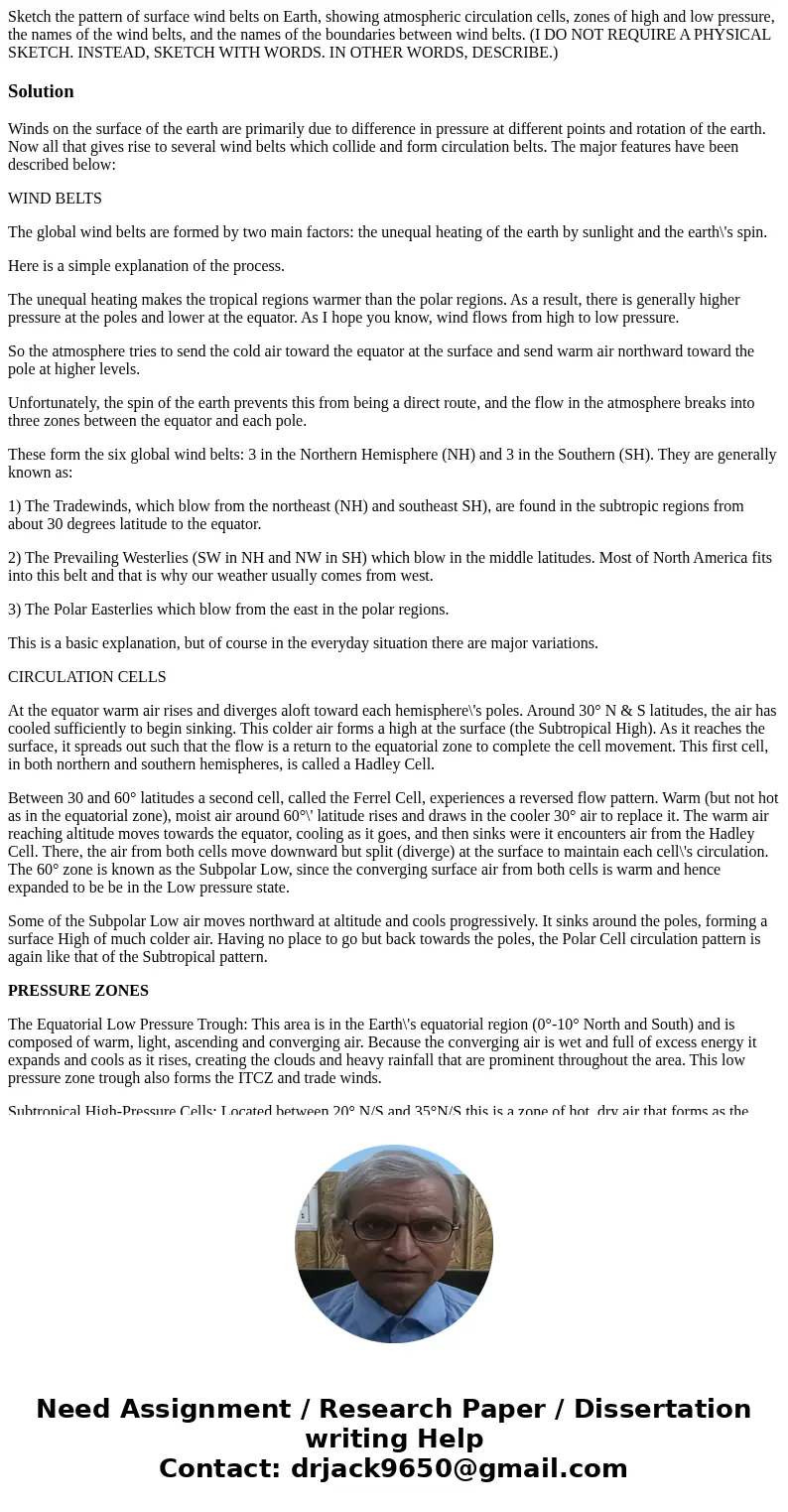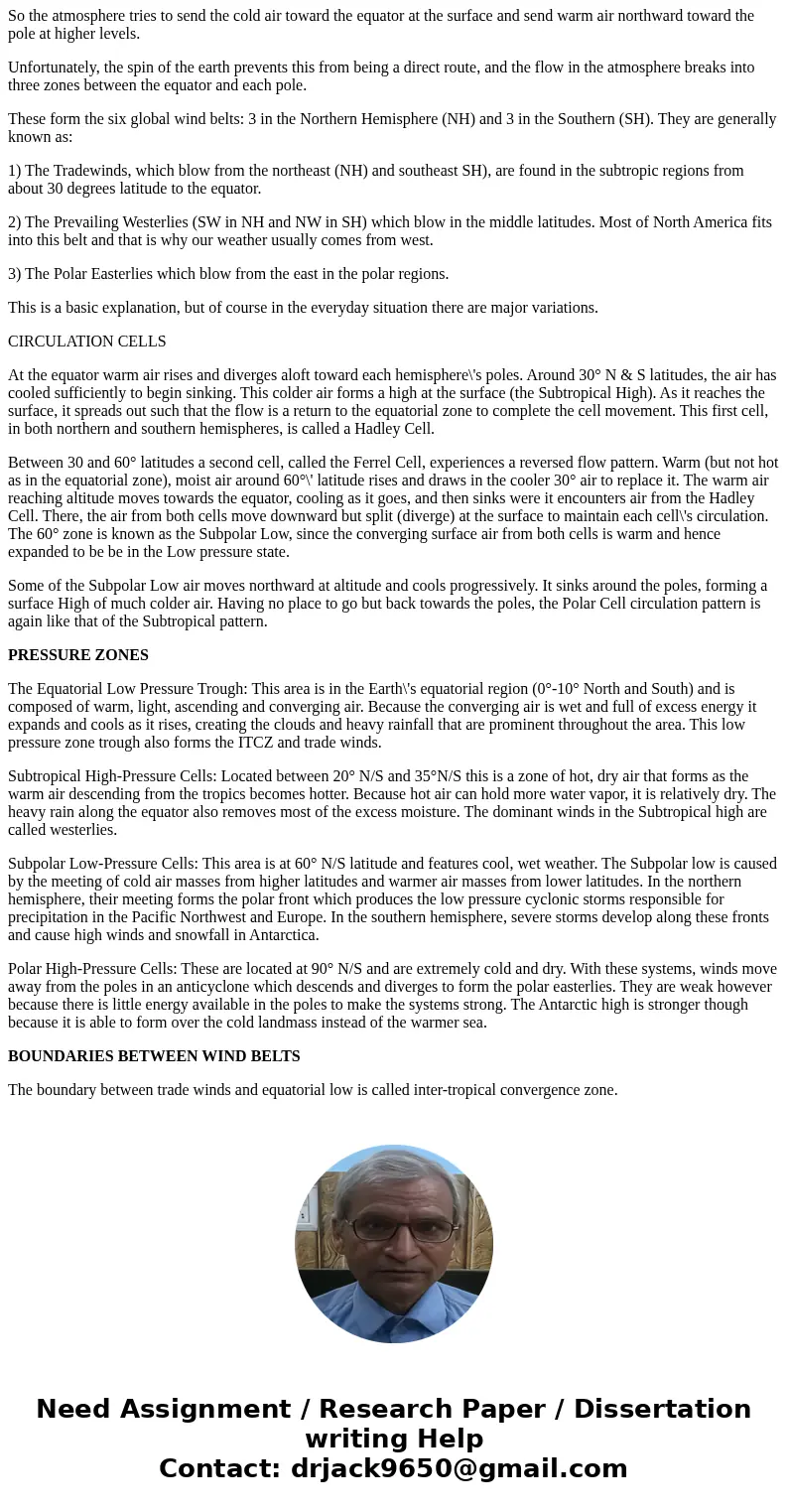Sketch the pattern of surface wind belts on Earth showing at
Sketch the pattern of surface wind belts on Earth, showing atmospheric circulation cells, zones of high and low pressure, the names of the wind belts, and the names of the boundaries between wind belts. (I DO NOT REQUIRE A PHYSICAL SKETCH. INSTEAD, SKETCH WITH WORDS. IN OTHER WORDS, DESCRIBE.)
Solution
Winds on the surface of the earth are primarily due to difference in pressure at different points and rotation of the earth. Now all that gives rise to several wind belts which collide and form circulation belts. The major features have been described below:
WIND BELTS
The global wind belts are formed by two main factors: the unequal heating of the earth by sunlight and the earth\'s spin.
Here is a simple explanation of the process.
The unequal heating makes the tropical regions warmer than the polar regions. As a result, there is generally higher pressure at the poles and lower at the equator. As I hope you know, wind flows from high to low pressure.
So the atmosphere tries to send the cold air toward the equator at the surface and send warm air northward toward the pole at higher levels.
Unfortunately, the spin of the earth prevents this from being a direct route, and the flow in the atmosphere breaks into three zones between the equator and each pole.
These form the six global wind belts: 3 in the Northern Hemisphere (NH) and 3 in the Southern (SH). They are generally known as:
1) The Tradewinds, which blow from the northeast (NH) and southeast SH), are found in the subtropic regions from about 30 degrees latitude to the equator.
2) The Prevailing Westerlies (SW in NH and NW in SH) which blow in the middle latitudes. Most of North America fits into this belt and that is why our weather usually comes from west.
3) The Polar Easterlies which blow from the east in the polar regions.
This is a basic explanation, but of course in the everyday situation there are major variations.
CIRCULATION CELLS
At the equator warm air rises and diverges aloft toward each hemisphere\'s poles. Around 30° N & S latitudes, the air has cooled sufficiently to begin sinking. This colder air forms a high at the surface (the Subtropical High). As it reaches the surface, it spreads out such that the flow is a return to the equatorial zone to complete the cell movement. This first cell, in both northern and southern hemispheres, is called a Hadley Cell.
Between 30 and 60° latitudes a second cell, called the Ferrel Cell, experiences a reversed flow pattern. Warm (but not hot as in the equatorial zone), moist air around 60°\' latitude rises and draws in the cooler 30° air to replace it. The warm air reaching altitude moves towards the equator, cooling as it goes, and then sinks were it encounters air from the Hadley Cell. There, the air from both cells move downward but split (diverge) at the surface to maintain each cell\'s circulation. The 60° zone is known as the Subpolar Low, since the converging surface air from both cells is warm and hence expanded to be be in the Low pressure state.
Some of the Subpolar Low air moves northward at altitude and cools progressively. It sinks around the poles, forming a surface High of much colder air. Having no place to go but back towards the poles, the Polar Cell circulation pattern is again like that of the Subtropical pattern.
PRESSURE ZONES
The Equatorial Low Pressure Trough: This area is in the Earth\'s equatorial region (0°-10° North and South) and is composed of warm, light, ascending and converging air. Because the converging air is wet and full of excess energy it expands and cools as it rises, creating the clouds and heavy rainfall that are prominent throughout the area. This low pressure zone trough also forms the ITCZ and trade winds.
Subtropical High-Pressure Cells: Located between 20° N/S and 35°N/S this is a zone of hot, dry air that forms as the warm air descending from the tropics becomes hotter. Because hot air can hold more water vapor, it is relatively dry. The heavy rain along the equator also removes most of the excess moisture. The dominant winds in the Subtropical high are called westerlies.
Subpolar Low-Pressure Cells: This area is at 60° N/S latitude and features cool, wet weather. The Subpolar low is caused by the meeting of cold air masses from higher latitudes and warmer air masses from lower latitudes. In the northern hemisphere, their meeting forms the polar front which produces the low pressure cyclonic storms responsible for precipitation in the Pacific Northwest and Europe. In the southern hemisphere, severe storms develop along these fronts and cause high winds and snowfall in Antarctica.
Polar High-Pressure Cells: These are located at 90° N/S and are extremely cold and dry. With these systems, winds move away from the poles in an anticyclone which descends and diverges to form the polar easterlies. They are weak however because there is little energy available in the poles to make the systems strong. The Antarctic high is stronger though because it is able to form over the cold landmass instead of the warmer sea.
BOUNDARIES BETWEEN WIND BELTS
The boundary between trade winds and equatorial low is called inter-tropical convergence zone.


 Homework Sourse
Homework Sourse